The average American pantry contains only three days’ worth of food. If you hope to survive the remaining 27 days, you’ll have to stock up some things.
What to store. Without electricity to refrigerate or cook with, canned and dried foods are your best choices. There’s no need to buy the high end “long shelf life” prepper foods because we’re not talking about the apocalypse. Instead, consider things like rice, pasta, grains, dried beans and canned sauces. 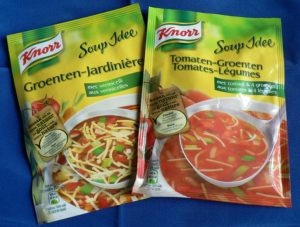 Instant soups (Knorr brand) are excellent, as are flavored instant potatoes. Unless you have a garden, your vegetables and fruits will come from a can and are economical in bulk from Sam’s, Price Club or Walmart during sales. Cereal or granola with “shelf milk” or powdered milk will get you through breakfasts. Also consider instant grits and flavored oatmeal that only need boiling water yet taste pretty good. Flavored drink mixes like Tang or Gatorade will break the monotony of water all the time and provide needed calories. Try to store up 30 days’ worth of the foods that your family likes and eats regularly, then rotate them into your everyday diets keep things fresh.
Instant soups (Knorr brand) are excellent, as are flavored instant potatoes. Unless you have a garden, your vegetables and fruits will come from a can and are economical in bulk from Sam’s, Price Club or Walmart during sales. Cereal or granola with “shelf milk” or powdered milk will get you through breakfasts. Also consider instant grits and flavored oatmeal that only need boiling water yet taste pretty good. Flavored drink mixes like Tang or Gatorade will break the monotony of water all the time and provide needed calories. Try to store up 30 days’ worth of the foods that your family likes and eats regularly, then rotate them into your everyday diets keep things fresh. 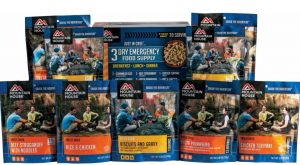 If you really want to splurge get a few long-shelf life freeze dried backpacking meals (https://www.mountainhouse.com/). They cost about $5-10 each, but the taste is worth it and they add a lot of variety to your diet. I’d recommend you avoid surplus military MREs because most of them are either government rejects or reached their expiration dates. Even fresh, MREs leave a lot to be desired.
If you really want to splurge get a few long-shelf life freeze dried backpacking meals (https://www.mountainhouse.com/). They cost about $5-10 each, but the taste is worth it and they add a lot of variety to your diet. I’d recommend you avoid surplus military MREs because most of them are either government rejects or reached their expiration dates. Even fresh, MREs leave a lot to be desired.
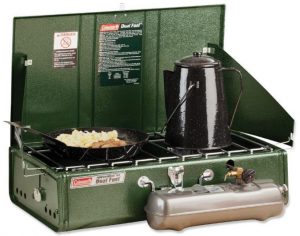 Your major consideration with cooking food is fuel consumption, because it’ll be in short supply and difficult to replenish. Fortunately, many foods (soups, dehydrated potatoes, instant grits & oatmeal, and freeze-dried backpacking meals) just need boiling water to reconstitute. They’re easy to prepare, taste good, and should get your preference in storage. Others foods like rice, beans, and pasta require simmering for long periods of time, which rapidly depletes your fuel supply. You can reduce cooking time by pre-soaking them overnight, but the cooking time is still considerable. If you’ll be cooking on a BBQ grill or camping stove, do a pre-event test to see how long it takes to cook your family’s favorite dishes, then make sure you stockpile enough fuel. A Coleman dual fueled camp stove is a useful tool in an emergency.
Your major consideration with cooking food is fuel consumption, because it’ll be in short supply and difficult to replenish. Fortunately, many foods (soups, dehydrated potatoes, instant grits & oatmeal, and freeze-dried backpacking meals) just need boiling water to reconstitute. They’re easy to prepare, taste good, and should get your preference in storage. Others foods like rice, beans, and pasta require simmering for long periods of time, which rapidly depletes your fuel supply. You can reduce cooking time by pre-soaking them overnight, but the cooking time is still considerable. If you’ll be cooking on a BBQ grill or camping stove, do a pre-event test to see how long it takes to cook your family’s favorite dishes, then make sure you stockpile enough fuel. A Coleman dual fueled camp stove is a useful tool in an emergency. 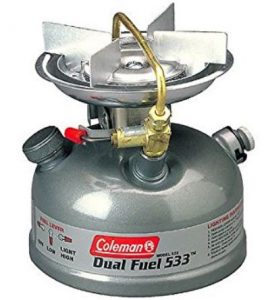 With 14,000 BTU and two burners it can boil water fast or simmer for hours while sipping on tiny amounts of fuel ($82 new @ Walmart). I see these all the time at yard sales for $25 or less. Coleman also makes a single-burner model ($61 @ Walmart), but it isn’t as stable or convenient as the double burner. Open fire cooking is also a possibility, but if you’ve never done it, you should know that it isn’t as easy as it looks on TV. Expect a lot of spillage, burned fingers, smoke, and melted utensils. Also, if you use normal pots and pans, most have composite handles that melt off. Temperature is hard to control so meals will be burnt on one side and raw on the other. Cleaning dishes used over an open fire is difficult and uses a lot of water. Just sayin’…
With 14,000 BTU and two burners it can boil water fast or simmer for hours while sipping on tiny amounts of fuel ($82 new @ Walmart). I see these all the time at yard sales for $25 or less. Coleman also makes a single-burner model ($61 @ Walmart), but it isn’t as stable or convenient as the double burner. Open fire cooking is also a possibility, but if you’ve never done it, you should know that it isn’t as easy as it looks on TV. Expect a lot of spillage, burned fingers, smoke, and melted utensils. Also, if you use normal pots and pans, most have composite handles that melt off. Temperature is hard to control so meals will be burnt on one side and raw on the other. Cleaning dishes used over an open fire is difficult and uses a lot of water. Just sayin’…
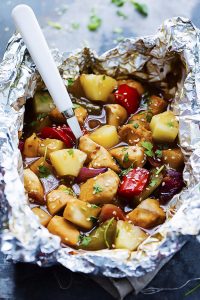 Paper plates, foil and plastic utensils. Without water washing dishes can be a pain. You’ll still have to wash pots and pans, but if you opt to use paper plates, cups and towels, and plastic utensils you can save a lot of time and water. At the end of the meal, just burn all the paper plates and cups to avoid attracting rodents and drop the utensils into your pocket for reuse. While not a paper product, tin foil is useful to bake things in and line pans. On my propane BBQ I’ve used foil to cook biscuits, corn bread, chicken, pheasant, dove, duck, turkey, squirrel, and various kinds of fish. When done, I scrape off the food and throw away the foil.
Paper plates, foil and plastic utensils. Without water washing dishes can be a pain. You’ll still have to wash pots and pans, but if you opt to use paper plates, cups and towels, and plastic utensils you can save a lot of time and water. At the end of the meal, just burn all the paper plates and cups to avoid attracting rodents and drop the utensils into your pocket for reuse. While not a paper product, tin foil is useful to bake things in and line pans. On my propane BBQ I’ve used foil to cook biscuits, corn bread, chicken, pheasant, dove, duck, turkey, squirrel, and various kinds of fish. When done, I scrape off the food and throw away the foil.
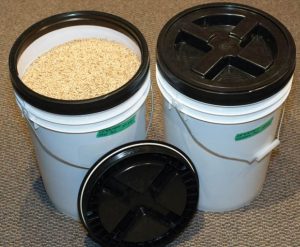 Storage (buckets w/lids). Some of the most useful things you can accumulate are 5-gallon plastic buckets. They can hold water, food, keep things dry, keep out rodents, and even be used as a toilet (more on this exciting subject later…). My local bakery gets their flour, sugar, honey, eggs, pickles, and other ingredients in 5-gallon plastic buckets. When the buckets are empty they sell them for $1 each just to get rid of them. I wash them out, wipe them with a weak bleach solution and store them in my garage until needed. They’re perfect for long term storage of pretty much anything, but especially dried food. To keep them moisture tight I use “Gamma Seal Lids”, that easily screw on and off. The Gamma Lids ($6 @ Home Depot) have a rubber gasket and convert 2, 3-1/2, 5, 6 and 7-gallon buckets into resealable, airtight containers.
Storage (buckets w/lids). Some of the most useful things you can accumulate are 5-gallon plastic buckets. They can hold water, food, keep things dry, keep out rodents, and even be used as a toilet (more on this exciting subject later…). My local bakery gets their flour, sugar, honey, eggs, pickles, and other ingredients in 5-gallon plastic buckets. When the buckets are empty they sell them for $1 each just to get rid of them. I wash them out, wipe them with a weak bleach solution and store them in my garage until needed. They’re perfect for long term storage of pretty much anything, but especially dried food. To keep them moisture tight I use “Gamma Seal Lids”, that easily screw on and off. The Gamma Lids ($6 @ Home Depot) have a rubber gasket and convert 2, 3-1/2, 5, 6 and 7-gallon buckets into resealable, airtight containers.
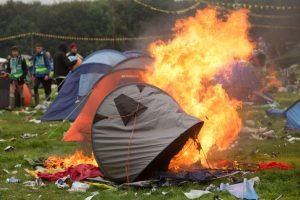 Nothing is better than sitting in front of a fire on a cold night. Having said that, I once lost a brand-new tent and sleeping bag because of an errant ember. By the time I realized the tent was on fire, it was fully engulfed. Fortunately for me it was the last night of a week-long camping trip and I drove home the next morning. In a post-event world any fire will be catastrophic and there’s no driving home afterwards. There’s no running water or fire department to call so fighting any fire can be almost impossible. Take extra precautions when you have a fire, making sure someone is always watching it. In the Army we called it a “fire watch”, a carryover from Civil War times, so I guess it was more a lesson learned than tradition.
Nothing is better than sitting in front of a fire on a cold night. Having said that, I once lost a brand-new tent and sleeping bag because of an errant ember. By the time I realized the tent was on fire, it was fully engulfed. Fortunately for me it was the last night of a week-long camping trip and I drove home the next morning. In a post-event world any fire will be catastrophic and there’s no driving home afterwards. There’s no running water or fire department to call so fighting any fire can be almost impossible. Take extra precautions when you have a fire, making sure someone is always watching it. In the Army we called it a “fire watch”, a carryover from Civil War times, so I guess it was more a lesson learned than tradition.
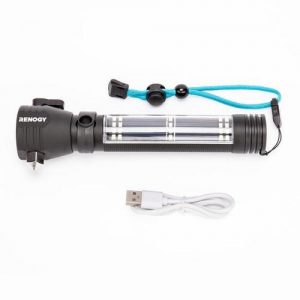 We have several friends living in Puerto Rico and after the hurricane they said that a good light is almost as valuable as water or food. Without electricity, sunset marks the end of doing anything productive or entertaining unless you have some kind of light. When our friends finally got a cellular connection and called us, one of the things they all asked for were flashlights and extra batteries. Since LEDs use a fraction of the energy that incandescent bulbs use and provide a brighter light, batteries last a lot longer. I’d recommend you consider buying head mounted LEDs, as well as a hand-held model that you can use as an area light.
We have several friends living in Puerto Rico and after the hurricane they said that a good light is almost as valuable as water or food. Without electricity, sunset marks the end of doing anything productive or entertaining unless you have some kind of light. When our friends finally got a cellular connection and called us, one of the things they all asked for were flashlights and extra batteries. Since LEDs use a fraction of the energy that incandescent bulbs use and provide a brighter light, batteries last a lot longer. I’d recommend you consider buying head mounted LEDs, as well as a hand-held model that you can use as an area light.  After the event, batteries will be hard to find, especially the “weird” sizes like CR123A and 18650. When choosing your headlamps and flashlights, select models that use common batteries like the AA and AAA, preferably all using the same size. Since batteries will be in short supply, you might consider buying a “survival” flashlight that has a built-in solar panel like the Renogy E.Lumen ($25). Also consider flashlights with built-in USB plugs that you can recharge with a power cell or solar panel, like the Goal Zero Torch ($79). One of my favorites is the Surefire Sidekick ($60 on eBay). About the size of a double pack of gum it has a long battery life and a high quality Cree LED with three levels of brightness.
After the event, batteries will be hard to find, especially the “weird” sizes like CR123A and 18650. When choosing your headlamps and flashlights, select models that use common batteries like the AA and AAA, preferably all using the same size. Since batteries will be in short supply, you might consider buying a “survival” flashlight that has a built-in solar panel like the Renogy E.Lumen ($25). Also consider flashlights with built-in USB plugs that you can recharge with a power cell or solar panel, like the Goal Zero Torch ($79). One of my favorites is the Surefire Sidekick ($60 on eBay). About the size of a double pack of gum it has a long battery life and a high quality Cree LED with three levels of brightness.